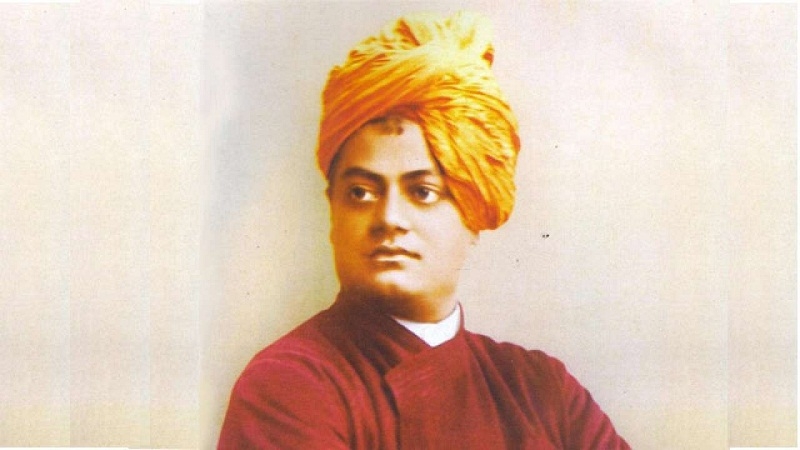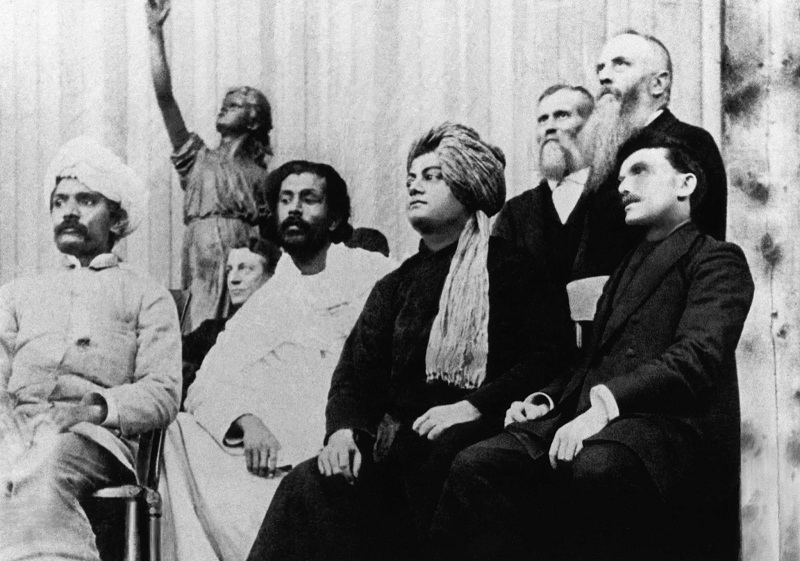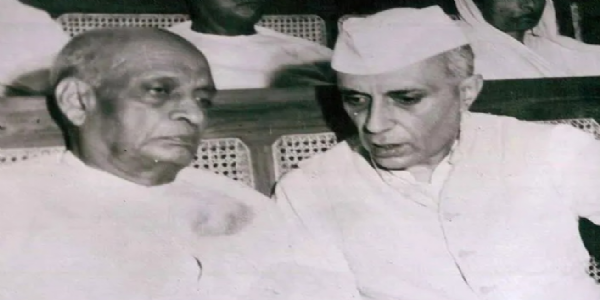Swami Vivekananda’s Mission to the West
Swami Vivekananda was the first Oriental who disseminated the message of Sanatana Dharma to the materially affluent West. It was he who for the first time opened to the Americans the vast panorama of Indian system of yoga.
Total Views | 325
 “Buddha had a message to the East; and I have a message to the West”
“Buddha had a message to the East; and I have a message to the West”
On January 28, 2013, the British Parliament passed a resolution in commemoration of 150th birth anniversary of Swami Vivekananda. The resolution was sponsored by Labor Party MP Barry Gardiner and co-sponsored by MPs Bob Blackman (Conservative Party), Peter Bottomley (Conservative Party), Mike Hancock (Liberal Democrats), Alen Meale (Labor Party), and Virendra Sharma (Labor Party).
The resolution said:
“That this House, on the 150th birth anniversary of Swami Vivekananda, recognizes the valuable contribution made by him to interfaith dialogue at international level, encouraging and promoting harmony and understanding between religions through his renowned lectures and presentations at the first World Parliament of Religions in Chicago in 1893,followed by his lecture tours in the US, England and mainland Europe; notes that these rectified and improved the understanding of the Hindu faith outside India and dwelt upon the universal goodness found within all religions; further notes that he inspired thousands to selflessly serve the distressed and those in need and promoted an egalitarian society free of all kinds of discrimination; and welcomes the celebrations of his 150th birth anniversary in the UK and throughout the world.”
Earlier in 2010, the US President Barack Obama paid high tributes to Swami Vivekananda. During his visit to India in 2010 Obama in his address to the Indian Parliament on November 8, 2010 said: “My confidence in our shared future is grounded in my respect for India’s treasured past—a civilization that has been shaping the world for thousands of years. Indians unlocked the intricacies of human body and the vastness of our universe…. India not only opened our minds, she expanded our moral imagination.”
And the sole credit for this ‘opening the minds and expanding moral imagination’ of the West must go unquestioningly and undoubtedly to one and the only one Swami Vivekananda. It was he who played a historic and heroic role in placing the jewels of the ancient Indian thought before the West and thus helped them in widening the dimensions and depth of their moral imagination.
Prior to his arrival at Kanyakumari, the Swami was wandering in Western India. During his wanderings a great scholar at Junagarh, impressed by his vast learning and restless energy, had told him to go to the West where “your thoughts would be better understood than in this country”, and had exhorted him: “Go and take it by storm and then return.”
Swami Vivekananda’a meditated at the ‘Sripad Shila’ in the Indian Ocean, some 200 meters from the mainland, where he got the clear vision of his mission to the West. Swami Vivekananda’s visit to Kanyakumari is the culminating and crowning act of his pilgrimage of India. He reached there on December 24, 1892 and swam to the rocks and meditated there for three days and nights and returned to the shore on the fourth day.
As Swami Ranganathananda says, “for the first time in the history of religion, the subject of meditation of this great monk was Man, the God sleeping in Man and not any far-away deity. He had seen in his own Master, Sri Ramakrishna, the very embodiment of spiritual tradition, of that eternal glory of the human spirit. Kanyakumari proved to be springboard for his future plans.”
Like Gautama Buddha, arising from his meditations at Bodhagaya and proceeding to Varanasi, Swami Vivekananda rose from his meditation at Kanyakumari and reached Madras with the same resolve of bahujan-hitay, bahujan-sukhay.
While analyzing the visit of Swami Vivekananda to the West we need to ponder over the following facts: Firstly, he was not sent there by an independent India because the country was reeling under the yoke of British slavery. Secondly, he was not sent as an official representative of any Indian religious authority or organization, because Indian spiritual tradition simply do not permit the single central powerful authority or church like the Semitic religions. He encountered difficulties at the time of admission to the Parliament of Religions in America later. We shall discuss about them at a later stage. The Swami went to the Parliament of Religions as a representative of the expanding spiritual consciousness of India in its fullness, through the instrumentality of a group of nationally sensitive Indian people.
The organizers of Parliament of Religions believed and confidently expected that it would end in the triumphant recognition of Christianity as the best religion of the world. The Roman Catholic organizers of the event wanted it to be a Christian show all round, as the Swami had mentioned. The Chairman of the Parliament Rev John Henry Barrows had extended invitation to colored representatives of non-Christian faiths only to ‘patronize’ them. He had cited the example of St Paul, who “was careful to find common ground for himself and his Greek auditors in Athens, before he preached to them Jesus and the resurrection”. Rev Barrows wrote on the subject defending his views. “Though light has no fellowship with darkness, light does have fellowship with twilight. God has not left himself without witness, and those who have the full light of the Cross should bear brotherly hearts towards all who grope in the dimmer illumination.”
However, the mask Rev Barrows put on before and during the Parliament completely fell afterwards, the praise Swami Vivekananda showered on him notwithstanding. All the fame that he had earned for successfully organizing the Parliament was lost, so far as India was concerned. In 1897 he came to India to preach Gospel and he preached “the most bigoted Christianity, with the result that nobody listened to him,” mentioned Swami Vivekananda in his letter to Mary Hale on April 28, 1897.
The Swami reached America towards the end of July 1893. He was shocked to know from the organizers that the Parliament was scheduled to be held in September and no one would be admitted as a delegate without valid credentials issued by the recognized religious organization or church. He had no such letter with him that would prove him as representative of Hinduism nor had he sufficient money to sustain himself till the Parliament began. Therefore, his sojourn in America was an extension of his wandering days, with kind Providence alone as his support. But he overcame all the difficulties in providential ways.
On his way to Boston, he became acquainted with Miss Kate Sanborn, an influential lady who invited him to stay at her beautiful house called “Breezy Meadows” in Metcalf, Massachusetts. She introduced him to Prof John H Wright, Professor of Greek at the Harvard University. Prof Wright was very much impressed by Swami Vivekananda during the four hour long conversation he had with him. The Professor insisted that he should represent Hinduism in the parliament. When the Swami expressed his difficulty in attending the Parliament for want of credentials, Prof Wright made a remark: “To ask you, Swami for your credentials is like asking the sun to state its right to shine.”
The Parliament of Religions opened on Monday, 11th September 1893 at the Art Institute building in presence of four thousand men and women who had gathered in the Hall of Columbus and the hundreds were standing in the galleries and doorways in breathless silence and in the mood of tense expectancy. The ten principal religions—Judaism, Islam, Buddhism, Hinduism, Taoism, Confucianism, Shintoism, Zoroastrianism, Catholicism and Protestantism—participated in the Parliament which began at the stroke of 10 am on that appointed historic day. Cardinal Gibbons, the highest dignitary of the Roman Catholic Church in America occupied the central seat. All the delegates were dressed in their respective appropriate apparels—Swami Vivekananda was conspicuous amongst all the delegates with his gorgeous red apparel and a yellow turban. Cardinal Gibbons wore crimson robes while Buddhists were in white, the Greeks in black garbs, Confucian in the dress of a mandarin, a young African prince in his richly embroidered robes.,
After the initial prayer of the Lord “Our Father who art in heaven.....,” the proceedings of the Parliament began. Swami Vivekananda sat rapt in silent meditation. Every time the Chairman called his name he would say, “no, not yet”. At last the Chairman insisted forcing the Swami to rise to speak. He bowed to Goddess Saraswati and began his speech with addressing the audience as “Sisters and Brothers of America”. And that worked like a magic spell! Before he could utter another word, the entire audience enthusiastically responded to him rising to their feet and sending deafening notes of applause over and over again. For full two minutes he attempted to speak but the wild enthusiasm and applause of the masses did not allow him to proceed. This thunderous applause instantaneously recognized that his thinking was different from the others. This was like heralding the advent of a new prophet!
 Swami Vivekananda at the Parliament of Religions at Chicago
Swami Vivekananda at the Parliament of Religions at Chicago
When the silence was restored he began his address greeting the youngest of the nation in the name of the most ancient order of monks in the world, the Vedic order of Sannyasis, a religion which has taught the world both tolerance and universal acceptance. It was a short speech but it voiced the spirit of the Parliament; its sense of universality captured the whole assembly. “It was like a tongue of flame” says Romain Rolland, “among the grey wastes if the cold dissertation it fired the souls of the listening throng.” The Swami quoted two passages from Hindu scriptures to drive his point home. “As the different streams having their sources in different places all mingle their waters in the sea, so O Lord, the different paths which men take, through different tendencies, various though they appear crooked or straight, all lead the Thee!” And the other: “Whosoever comes to Me, through whatsoever form, I reach him; all men are struggling through paths that in the end lead to Me.”
Sister Nivedita has caught the spirit of his addresses. In her introduction to the Complete Works of Swami Vivekananda she says, “Of the Swami’s address before the Parliament of Religions, it may be said that when he began to speak, it was the religious ideas of Hindus; but when he ended Hinduism had been created. … it was the religious consciousness of India that spoke through him, the message of his whole people, as determined by their whole past…”
From the first speech he delivered at the Parliament of Religions to August 1895 when he set sail to England en route India, Swami Vivekananda had a hectic time in the United States. He was the star of attraction of the American people and media. The important daily papers of Chicago—The Chicago Daily Tribune, and The Chicago Daily News, The Boston Evening Transcript, The Review of Reviews, were all praise for him. The Boston Evening Transcript wrote, “He is a great favorite at the Parliament from the grandeur of his sentiments and his appearances as well. If he merely crossed the platform, he is applauded; and this marked approval of thousand he accepts in a child-like spirit of gratification without a trace of conceit……” The Review of Reviews described his address as ‘noble and sublime.’
During his stay in America Swami Vivekananda delivered lectures on India and Vedanta in different parts of that opulent nation. His activities extended to most of the important American cities and to the centers of learning like Harvard University. He got opportunity to exchange ideas with learned American people like Prof William James, Prof John H Wright and electrician Nicolas Tesla. He was even offered a chair in Oriental Philosophy at Harvard and chair in Sanskrit at Columbia University. Several earnest aspirants, men and women, gathered around him as close circle of students and friends, notable amongst them were members of the Hale family, Mrs. & Mr. Leggett, Ms MacLeod, Mrs. Ole Bull, Dr Allen Day, Ms S E Waldo, Prof Wright and others.
This popularity of Swami Vivekananda, a Hindoo monk, did not augur well among the jealous fanatic Christians who tried to tarnish his image by stooping to very low levels. The Christina missionaries found that with the exposition of Hinduism by the Swami many Americans began to doubt the propriety of sending the missionaries to the country that had produced a Vivekananda. They felt that the source of their funds might get dried up if things went on that way. They found good allies in the Theosophists and Brahmo Samajist who were equally jealous of Swami Vivekananda’s success and joined hands with the Christian missionaries to malign the image of the Swami. They launched a campaign of character assassination of Vivekananda depicting him as a sexual pervert and warning American households against entertaining him. But the Swami’s friends in America, who knew the reality, came forward to defend him whenever the need arose.
After having established a permanent centre of Vedanta work in New York with F H Leggett as the President, Swami Vivekananda next turned his attention to England from where he was getting pressing invitations. He sailed for London from New York on August 17, 1895 and after a short halt at Paris, reached London on September 10, 1895. He stayed there for four months and returned to America in April 1896. He again visited London in September 1896 and continued to work there till December that year. After that he sailed back to India with the batch of his Western disciples like Mr. and Mrs. Sevier and Mr. Goodwin.
In London also, the lectures and discourses given by the Swami attracted large number of listeners including the high-ranking people of the English society. Leading news papers gave wide publicity to his thoughts and views and unlike the American experience he did not have to encounter any slanderous campaign of the Christian missionaries in London. This welcome and receptivity in England was unexpected for him, especially when his country was subjugated and enslaved by them. He himself had admitted it later when he said, “no one landed on the shore of England with so much prejudice against the British as me, but experience led me to admire their character—conservative yet practical, heroic in mould yet hiding a very soft current of feeling underneath.”
During his stay in England and Europe he met the most famous and distinguished Indologists Prof. Max Muller and Prof Paul Deussen. Prof Max Muller had already written about Sri Ramakrishna in his article ‘A Real Mahatma’ on this great personality. On the information supplied by Swami Vivekananda Prof Max Muller wrote his book ‘Ramakrishna: His life and sayings’—the first comprehensive book on the Master to appear in English language. It greatly helped in promoting the Vedantic teachings of the Swami in those days.
Thus, from 1893 to 1896 the Swami engaged himself in laying the firm foundation of Vedanta in America and England where he was able to establish Vedanta centers—at New York and at London. When he left for India he deputed Swami Saradananda to look after the centre at New York while Swami Abhedananda was sent to London for the same purpose. England gave him very valuable friends and disciples like Margaret Noble later known as Sister Nivedita, Henrietta Muller and Mr Goodwin. All these disciples followed the Swami to India and extended all help in his mission.
Swami Vivekananda returned to India on December 16, 1896 and till his second voyage to the west in 1899, he engaged himself in consolidating the work in India. When he arrived on January 15, 1897 he was given a magnificent ovation by the people of Colombo who formed a procession and rained flowers on him. Swami Vivekananda embarked upon another visit to the West and set sail for the same in June 1899 on a second tour of America and Europe. He was accompanied by Swami Turiyananda and Sister Nivedita. They reached London after a voyage of 42 days because of the rough sea. After staying there for two weeks he proceeded to America and reached New York on August 28, 1899. He was particularly happy to see the achievements of Swami Abhedananda who established the Vedanta society on a firm foundation.
When Swami Vivekananda arrived in America, the nation had become a massive economic power house. The society was experiencing affluence of highest degree. The nation was making fast progress in science and technology. But there was ‘Other America’ also where there lived people deprived and non-privileged. The conscienceless and compassionless materialism was causing great harm to the constitution of America based on the principles of noble human values. It was in this atmosphere of growing material richness and degrading moral values that great savant of the East arrived at the American scene. And, with his electrifying discourses Vivekananda changed the direction of their thinking, their living and their lives too. As Jagmohan, former Governor of Jammu and Kashmir and former Union Minister says in his well researched article ‘Vivekananda’s influence on American thought’, “It was Vivekananda who, for the first time, opened to the Americans the vast panorama of the Indian system of Yoga which had been designed to secure all round development of man.”
When the response comes from the west the tunnel connecting the West and East would be complete, and a new culture, which will be essentially human culture, would be evolved, making for spiritual growth of man everywhere marking the fulfillment of the purposes of the coming of Sri Ramakrishna and Swami Vivekananda in this modern age.
Bharati Web








